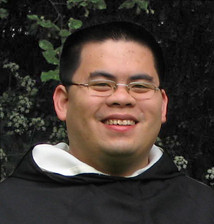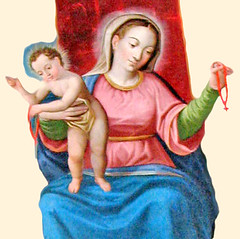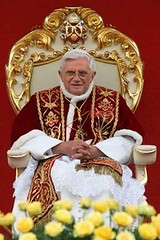The Priory of San Esteban (Prima Pars)
 The Friars Preachers arrived at the university town of Salamanca in 1224 and settled on the banks of the river Tormes without the city walls. That priory was destroyed by flooding in 1256 causing them to move to the site of the existing Romanesque St Stephen's church on 9 November 1256. The bishop had given them that site along with an adjoining cemetery and land on which the friars proceeded to build a priory, cloister and other adjacent buildings. Vestiges of these structures survive but most have been reconstructed 16th century (left, the Facade of the Priory), a golden age for Salamanca.
The Friars Preachers arrived at the university town of Salamanca in 1224 and settled on the banks of the river Tormes without the city walls. That priory was destroyed by flooding in 1256 causing them to move to the site of the existing Romanesque St Stephen's church on 9 November 1256. The bishop had given them that site along with an adjoining cemetery and land on which the friars proceeded to build a priory, cloister and other adjacent buildings. Vestiges of these structures survive but most have been reconstructed 16th century (left, the Facade of the Priory), a golden age for Salamanca. 
On the right is the so-called Cloister of Processions, the main cloister of the convent. It was completed in 1544 and designed by fray Martin de Santiago. As is the style of many such cloisters it has two levels and I am shown below in the Upper Cloister which is reached via a stunning Stone Staircase built by fray Domingo de Soto, just after he returned in 1553 from the Council of Trent.
 It is from this convent of San Esteban (St Stephen) that the first Dominican friars to evangelize the Americas and the Philippines were sent. Among it's sons are fray Domingo Salazar, first Bishop of Manila; fray Francisco de Vitoria, founder of the 'Salamanca School' and creator of International Law; fray Domingo de Soto, inquisitor and a principal theologian at the Council of Trent; fray Diego de Deza, confessor and protector of Christopher Columbus who was a visitor of this house; Cardinal Juan de Torquemada and St Vincent Ferrer.
It is from this convent of San Esteban (St Stephen) that the first Dominican friars to evangelize the Americas and the Philippines were sent. Among it's sons are fray Domingo Salazar, first Bishop of Manila; fray Francisco de Vitoria, founder of the 'Salamanca School' and creator of International Law; fray Domingo de Soto, inquisitor and a principal theologian at the Council of Trent; fray Diego de Deza, confessor and protector of Christopher Columbus who was a visitor of this house; Cardinal Juan de Torquemada and St Vincent Ferrer.  Many of these luminaries are depicted in the new Chapter House of the Convent (shown on the right) which was begun in 1627 and replaced the old Chapter House which had become too small. Nevertheless many of the famous sons of this Convent are buried in the original Chapter House.
Many of these luminaries are depicted in the new Chapter House of the Convent (shown on the right) which was begun in 1627 and replaced the old Chapter House which had become too small. Nevertheless many of the famous sons of this Convent are buried in the original Chapter House.St Teresa of Avila (whose home and convent in Avila we visited later in the week) also went to San Esteban, as a penitent, whenever she was in Salamanca and the confessional she used can still be seen. She is known to have said that the best confessors were Dominicans and it seems to have been her practice to avail herself of a Dominican confessor whenever she could. In the photo below, Br Paul is sitting on the friar's side of the Confessional on a rather uncomfortable stone stool; the friars had access to the confessional through doors in their cloister but the penitents entered their side of the confessional through a door in the Priory church. This meant that the confessor did not have to leave the clausura in order to hear confessions!

The Priory is now home to a community of about two dozen friars and also several storks who nest on the roof and gables of the convent and the church! Below is just one of many which I spotted and many churches in Salamanca and around the region seem to have stork-nests on them. It made me think of the psalm:
 "How lovely is your dwelling place, O Lord of Hosts... even the sparrow finds a home, and the swallow a nest for herself, where she may lay her young, at your altars, O Lord of Hosts" (Ps 84:1, 3).
"How lovely is your dwelling place, O Lord of Hosts... even the sparrow finds a home, and the swallow a nest for herself, where she may lay her young, at your altars, O Lord of Hosts" (Ps 84:1, 3).Tomorrow: More photos of the Priory and the Church of San Esteban.







0 Comments:
Post a Comment
<< Home